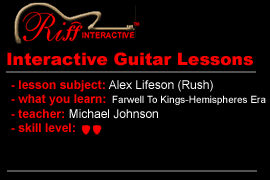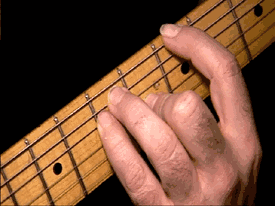Scroll through the lesson and click on notation/video/audio links to load the interactive players.
Please subscribe to get full access to all lessons for only $7.95/month PLUS 1 week free trial.

Riff Interactive lessons are
LESS expensive and
MORE interactive than alternatives!
More Info
|
|

Teacher: Welcome class to the lesson on the
style of Alex Lifeson of Rush. In this lesson we will continue learning licks
and riffs from the Farwell to Kings and Hemispheres era. This is the era where
Alex would incorporate classical guitar and polytonal chords to add more
dynamics. This is also when Neil Peart added more fusion drum
patterns. Notice in the lesson sample I start with a classical piece then
lead into a polytonal chord type chord progression. Let's get started.
Lesson Sample - Lowband
- 1.5 Meg
Lesson Sample -
Highband - 4 Meg
Teacher: Here's the
opening classical guitar part.
Part 1
Part 1
Part 1 -
Picking
Teacher:
This section starts with a B/C interval then moving to D and then to A/B. You
shift to D/F# and then descend the A Mixolydian using a run. The chords end with
G, Bb/C and D/F#. The next section continues by picking barre chords. The
picking pattern gives the chords a classical sound.
Part
2
Part 2 - Chords
& Picking
Teacher:
Notice how I use my thumb and 1st finger to play the chords. It can be a
little tricky to play, but you generally pick the thumb and 1st finger at the
same time and move the 1st finger to play the lower notes. Here's the jam track
for parts 1 & 2.
Looping Jam Track 1 - Lowband
Teacher:
Alex Lifeson will often switch between acoustic and electric guitars. He has a
stand for the acoustic to where he can jump from the acoustic on the stand and
then play his electric which he holds on his shoulder. Here's the electric
part.
Part
3
Part 3
Teacher:
This polytonal chord is easy to play, you simply fret a G chord on the 8th fret
position and use a picking pattern. This combination sounds dramatic. You can
finger either the 3rd finger barred on the 8th fret of the 1st and 2nd string,
or use the 4th finger on the 1st string and the 3rd finger on the 2nd string.
Here's the jam track.
Looping Jam Track 2 - Lowband
Teacher:
Notice how the polytonal chords accent the fusion drum beat. The next section
will so some licks played over a mellow sounding jam track, first here's the jam
track.
Looping Jam
Track 3 - Lowband
Teacher:
Notice the chords in the jam track leave space for the solo to stand out. Here's
the first lick.
Part 4 - Solo 1
Part 4 - Solo
1
Teacher:
This solo is basically in Am, you can use various related modes at times
throughout the solo. Notice the gradually bend at the beginning of the solo,
then playing the note bent to one whole-step, and then bend and release. Here's
the next part of the solo.
Part 4 - Solo 2
Part 4 - Solo
2
Teacher:
This section will shift positions related to the Am scale. Notice the half-step
bend on the 12tf fret. The end of this section leads you into the main scale
pattern of the A Minor on the 5th fret. The next section will lead into the E
Phrygian on the 12th fret. Here's the section.
Part 4 -
Solo 3
Part 4 - Solo
3
Teacher:
This is a nice sounding run, it uses a hammer/pull-off combination as you
descend the scale pattern. Towards the end you bend the 14th fret/3rd string one
and a half-steps. The next section has a nice triad
sound.
Part 4 -
Solo 4
Part 4 - Solo
4
Teacher:
You start this lick with a C Maj triad, then alter the pattern. You end the solo
by playing a descending run in the last scale. The next section uses more
polytone chords
Part 5
Part 5
Teacher:
The chord fingering used for each of these position is a barre chord, but not
barring the 1st and 2nd string, allowing them to play open. Here's a
picture.
Polytone
Chord Fingering

Teacher: Notice how the 1st finger is arched to
avoid playing any of the other strings. Here's the jam track for this section,
the 1st, 2nd and 3rd chord positions are played longer in the jam track
than the tab I just gave you.
Looping Jam Track 4 - Lowband
Teacher:
Alex/Rush will transition from a mellow section into power chords to create a
dramatic sound. Here's the power chord section.
Part
6
Part 6
Teacher:
Notice how the chords are accented by the bass and drum. Notice how the
ascending and descending scale run fills up the open space between the power
chords. The scale pattern is in Am. Here's the jam track.
Looping Jam
Track 5 - Lowband
Teacher:
You can also play the polytonal chords to accent a distorted bass, drums and
guitar accents. Here's the chord and pattern used.
Part
7
Teacher:
Well that's it for this lesson. I hope this gives you a better understanding of
Alex Lifeson and Rush. See you next
lesson!
Dennis:
thanx micheal
Dennis: see ya next week
Teacher: Thanks!
neil:
thanks cool lesson
|
<< load notation from left
|
|
<< load audio from left
|
<< load audio from left
|